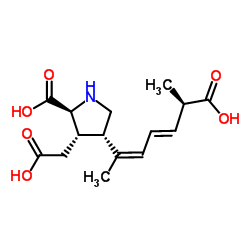Domoic acid

Domoic acid structure
|
Common Name | Domoic acid | ||
|---|---|---|---|---|
| CAS Number | 14277-97-5 | Molecular Weight | 311.330 | |
| Density | 1.3±0.1 g/cm3 | Boiling Point | 607.2±55.0 °C at 760 mmHg | |
| Molecular Formula | C15H21NO6 | Melting Point | 228ºC | |
| MSDS | Chinese USA | Flash Point | 321.0±31.5 °C | |
| Symbol |

GHS07 |
Signal Word | Warning | |
|
Metal-organic framework UiO-66 modified magnetite@silica core-shell magnetic microspheres for magnetic solid-phase extraction of domoic acid from shellfish samples.
J. Chromatogr. A. 1400 , 10-8, (2015) Fe3O4@SiO2@UiO-66 core-shell magnetic microspheres were synthesized and characterized by transmission electron microscopy, scanning electron microscopy, X-ray diffraction, Fourier transform infrared spectrometry, vibrating sample magnetometry, nitrogen adsorp... |
|
|
The prostaglandin EP1 receptor potentiates kainate receptor activation via a protein kinase C pathway and exacerbates status epilepticus.
Neurobiol. Dis. 70 , 74-89, (2014) Prostaglandin E2 (PGE2) regulates membrane excitability, synaptic transmission, plasticity, and neuronal survival. The consequences of PGE2 release following seizures has been the subject of much study. Here we demonstrate that the prostaglandin E2 receptor 1... |
|
|
Ursolic acid improves domoic acid-induced cognitive deficits in mice.
Toxicol. Appl. Pharmacol. 271(2) , 127-36, (2013) Our previous findings suggest that mitochondrial dysfunction is the mechanism underlying cognitive deficits induced by domoic acid (DA). Ursolic acid (UA), a natural triterpenoid compound, possesses many important biological functions. Evidence shows that UA ... |
|
|
Algal toxins and reverse osmosis desalination operations: laboratory bench testing and field monitoring of domoic acid, saxitoxin, brevetoxin and okadaic acid.
Water Res. 46(19) , 6563-73, (2012) The occurrence and intensity of harmful algal blooms (HABs) have been increasing globally during the past few decades. The impact of these events on seawater desalination facilities has become an important topic in recent years due to enhanced societal intere... |
|
|
Multiplex biotoxin surface plasmon resonance method for marine biotoxins in algal and seawater samples.
Environ. Sci. Pollut. Res. Int. 20(10) , 6794-807, (2013) A multiplex surface plasmon resonance (SPR) biosensor method for the detection of paralytic shellfish poisoning (PSP) toxins, okadaic acid (and analogues) and domoic acid was developed. This method was compared to enzyme-linked immunosorbent assay (ELISA) met... |
|
|
Molecular and pharmacological evidence for a facilitatory functional role of pre-synaptic GLUK2/3 kainate receptors on GABA release in rat trigeminal caudal nucleus.
Eur. J. Pain 16(8) , 1148-57, (2012) Gamma-aminobutyric acid (GABA) and glutamate (GLU) are involved in nociceptive signals processing in the trigeminal system. In this study, we investigated the influence of excitatory transmission on GABA release in nerve terminals isolated from the rat trigem... |
|
|
ATP-binding Cassette Subfamily C Member 5 (ABCC5) Functions as an Efflux Transporter of Glutamate Conjugates and Analogs.
J. Biol. Chem. 290 , 30429-40, (2015) The ubiquitous efflux transporter ABCC5 (ATP-binding cassette subfamily C member 5) is present at high levels in the blood-brain barrier, neurons, and glia, but its in vivo substrates and function are not known. Using untargeted metabolomic screens, we show t... |
|
|
The activation of glutamate receptors by kainic acid and domoic acid.
Nat. Toxins 6 , 153-158, (1998) The neurotoxins kainic acid and domoic acid are potent agonists at the kainate and alphaamino-5-methyl-3-hydroxyisoxazolone-4-propionate (AMPA) subclasses of ionotropic glutamate receptors. Although it is well established that AMPA receptors mediate fast exci... |
|
|
[Domoic acid and glutamate receptors].
Wei Sheng Yan Jiu 29(4) , 255-6, back cover, (2000) Domoic acid is a kind of neurotoxin produced by diatoms and accumulated in food chain, which is harmful to the human health. The N-methyl-D-aspartate receptor and kainic acid/alpha-amino-3-hydroxy-5-methylisoxazole-4-propionate receptor could be activated by ... |
|
|
Domoic acid-induced neurotoxicity in the hippocampus of adult rats.
Neurotox. Res. 6(2) , 105-17, (2004) Domoic acid (DA), an agonist of non-N-methyl-D-aspartate (non-NMDA) receptor subtype including kainate receptor, was identified as a potent neurotoxin showing involvement in neuropathological processes like neuronal degeneration and atrophy. In the past decad... |